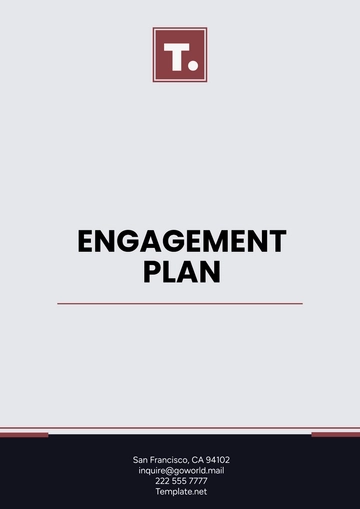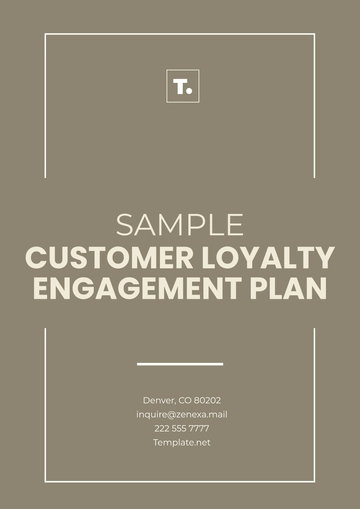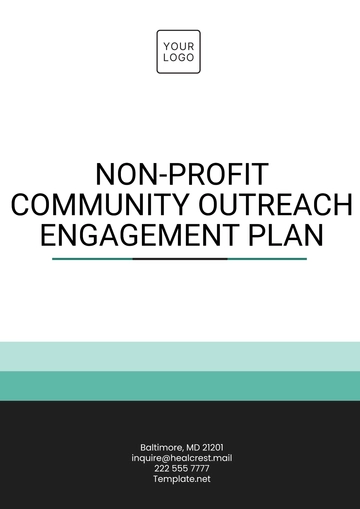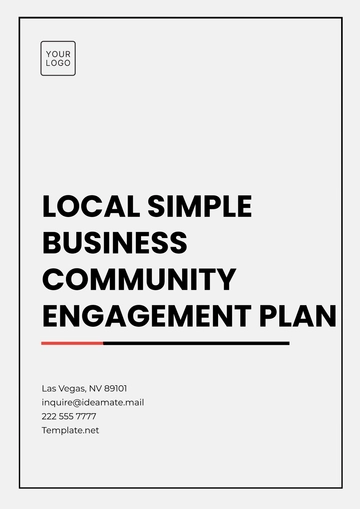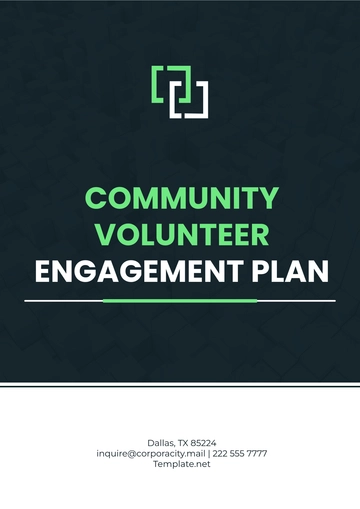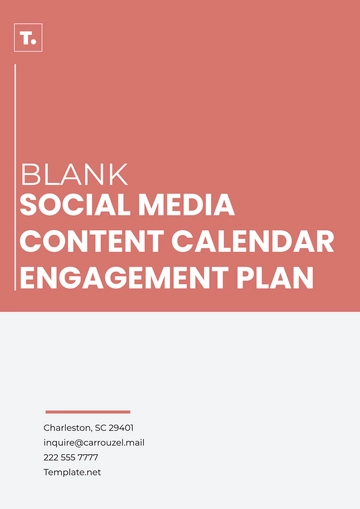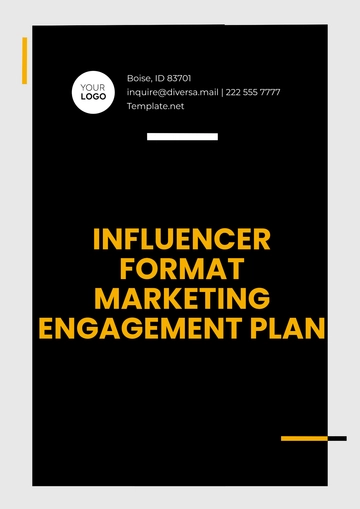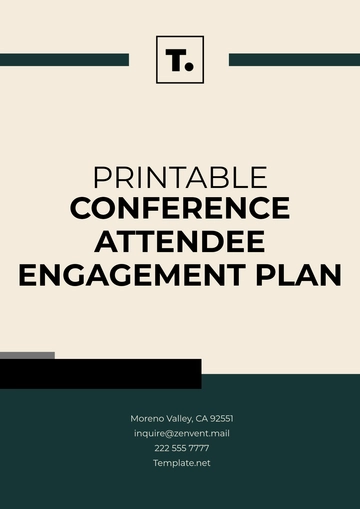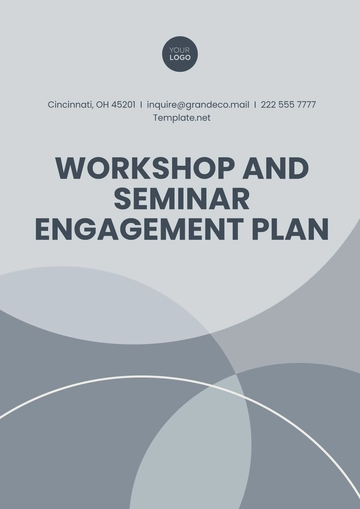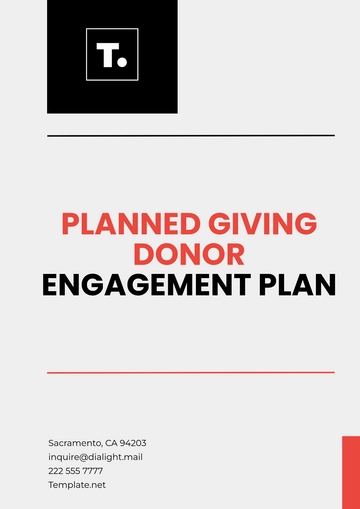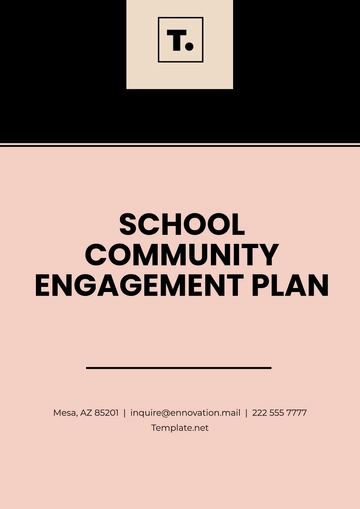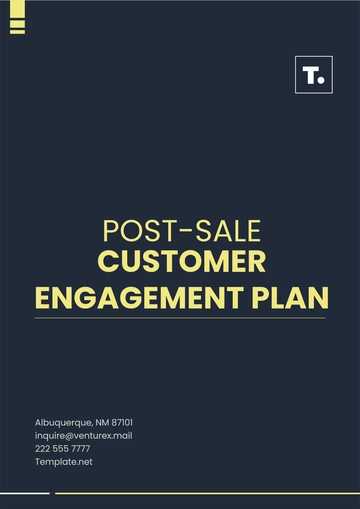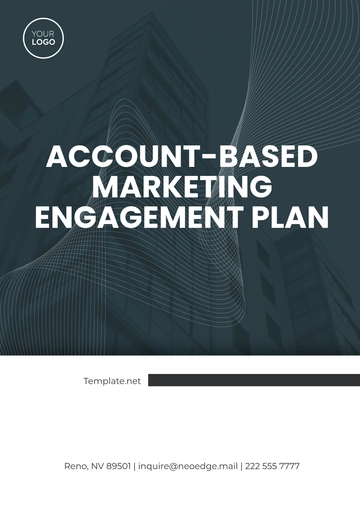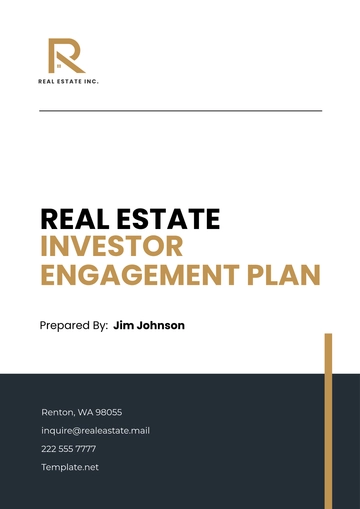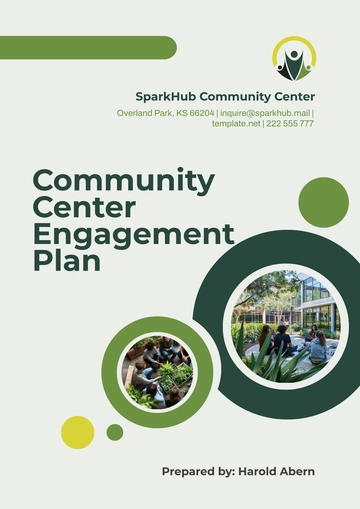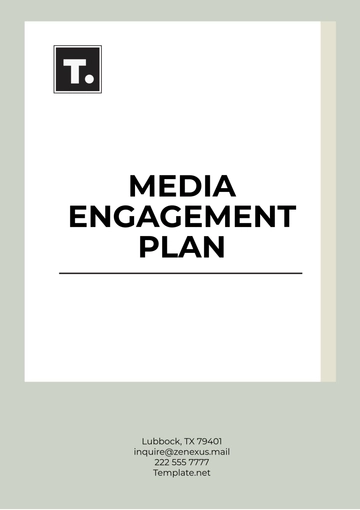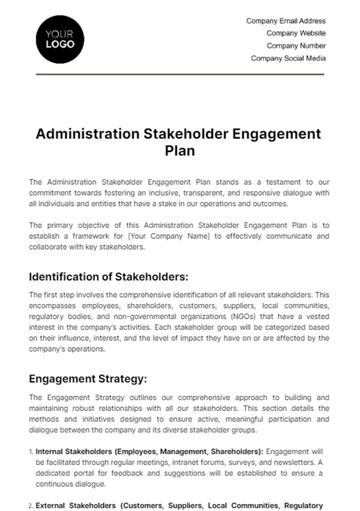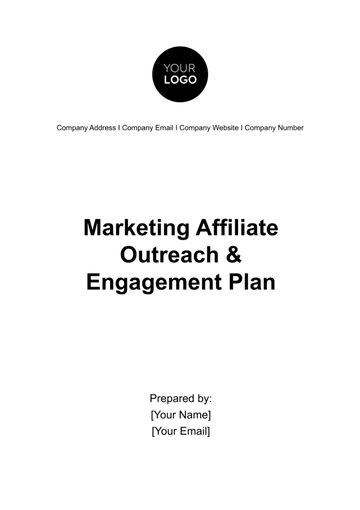Free Account-Based Marketing Engagement Plan
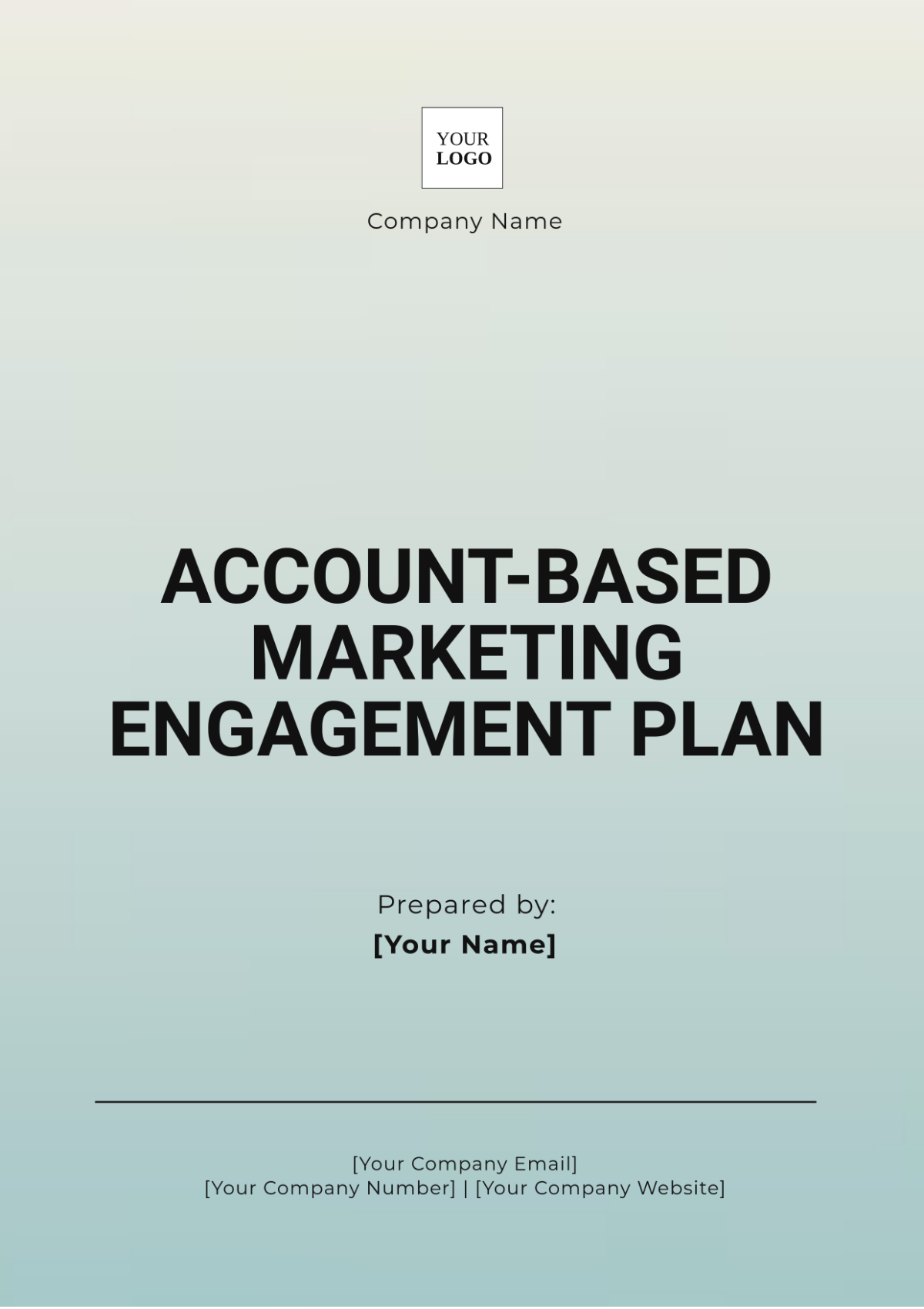
Prepared by: [Your Name]
Company Name: [Your Company Name]
Date: October 20, 2050
Introduction
This Account-Based Marketing Engagement Plan serves as a roadmap for effectively targeting and engaging high-value accounts. The plan aligns marketing and sales efforts to deliver personalized strategies that address the unique needs of each account, ensuring measurable results and sustainable growth.
Objectives
The primary objectives of this plan are:
Strengthen Engagement: Build meaningful relationships with key decision-makers in target accounts.
Drive Revenue Growth: Focus on accounts with the highest revenue potential to maximize ROI.
Align Teams: Foster collaboration between marketing and sales teams to deliver consistent messaging and results.
Enhance Customer Retention: Deepen relationships with existing accounts to increase lifetime value.
Account Selection
Criteria for Target Accounts:
Annual revenue exceeding $5 million.
Industries aligned with core offerings (e.g., technology, healthcare).
Accounts showing active interest in products or services (e.g., website visits, email opens).
Existing clients with upselling or cross-selling potential.
Target Accounts
Account Name | Industry | Revenue | Decision-Makers | Potential Opportunity |
|---|---|---|---|---|
BluCurrent | Technology | $20 million | Ena Cassin, CIO | $500,000 annually |
Primeve | Healthcare | $10 million | John Casper, Procurement Manager | $250,000 annually |
Engagement Strategy
1. Personalized Messaging
Craft unique value propositions tailored to each account’s challenges and goals.
Example: For Account A, emphasize solutions that enhance cloud computing efficiency.
2. Content Creation
Develop high-impact, account-specific content such as case studies, whitepapers, and personalized videos.
Delivery Channels: Email campaigns, LinkedIn messages, and direct mail.
3. Multi-Channel Outreach
Implement a coordinated approach across email, social media, phone calls, and in-person meetings.
Example: LinkedIn ads targeting decision-makers from Account B, followed by a direct email campaign.
4. Events and Webinars
Host exclusive events, such as virtual roundtables or webinars, to showcase solutions and foster direct interactions.
Example: A webinar on “Innovations in Healthcare IT” for Account B stakeholders.
Timeline
Phase | Activities | Timeline | Responsible Team |
|---|---|---|---|
Phase 1: Research | Identify target accounts and gather insights. | Week 1-2 | Marketing, Sales |
Phase 2: Planning | Develop personalized strategies and messaging. | Week 3 | Marketing |
Phase 3: Execution | Launch campaigns and initiate outreach efforts. | Week 4-8 | Sales, Marketing |
Phase 4: Evaluation | Analyze performance and refine strategies. | Week 9+ | Marketing |
Metrics and Evaluation
Key Metric | Target | Measurement Method |
|---|---|---|
Engagement Rate | 40% of targeted contacts | Email open rates, webinar attendance |
Conversion Rate | 20% of engaged accounts | Closed-won deals |
Account Penetration | 80% engagement across key stakeholders | CRM data |
Revenue Generated | $1 million from target accounts | Financial reporting |
Team Responsibilities
Role | Responsibilities |
|---|---|
Marketing Team | Develop content, run campaigns and track metrics. |
Sales Team | Engage leads, nurture relationships, and close deals. |
Account Managers | Build long-term relationships with key accounts. |
Customer Success Team | Provide ongoing support and identify growth opportunities. |
Continuous Improvement
Regularly review performance metrics and feedback to refine the plan. Quarterly meetings between marketing and sales teams will ensure alignment and identify areas for improvement.
Conclusion
This Account-Based Marketing Engagement Plan establishes a structured and tailored approach to reaching high-value accounts. By aligning resources, focusing on personalized engagement, and tracking outcomes, the plan aims to deliver significant revenue growth and strengthened relationships with target accounts.
- 100% Customizable, free editor
- Access 1 Million+ Templates, photo’s & graphics
- Download or share as a template
- Click and replace photos, graphics, text, backgrounds
- Resize, crop, AI write & more
- Access advanced editor
Maximize your marketing efforts with the Account-Based Marketing Engagement Plan Template from Template.net. This editable and customizable template provides a structured approach to tailor your marketing strategies for specific accounts. Utilize our AI Editor Tool to effortlessly adapt your plans, ensuring effective communication that resonates with your target audience and drives measurable results. Start today!
You may also like
- Finance Plan
- Construction Plan
- Sales Plan
- Development Plan
- Career Plan
- Budget Plan
- HR Plan
- Education Plan
- Transition Plan
- Work Plan
- Training Plan
- Communication Plan
- Operation Plan
- Health And Safety Plan
- Strategy Plan
- Professional Development Plan
- Advertising Plan
- Risk Management Plan
- Restaurant Plan
- School Plan
- Nursing Home Patient Care Plan
- Nursing Care Plan
- Plan Event
- Startup Plan
- Social Media Plan
- Staffing Plan
- Annual Plan
- Content Plan
- Payment Plan
- Implementation Plan
- Hotel Plan
- Workout Plan
- Accounting Plan
- Campaign Plan
- Essay Plan
- 30 60 90 Day Plan
- Research Plan
- Recruitment Plan
- 90 Day Plan
- Quarterly Plan
- Emergency Plan
- 5 Year Plan
- Gym Plan
- Personal Plan
- IT and Software Plan
- Treatment Plan
- Real Estate Plan
- Law Firm Plan
- Healthcare Plan
- Improvement Plan
- Media Plan
- 5 Year Business Plan
- Learning Plan
- Marketing Campaign Plan
- Travel Agency Plan
- Cleaning Services Plan
- Interior Design Plan
- Performance Plan
- PR Plan
- Birth Plan
- Life Plan
- SEO Plan
- Disaster Recovery Plan
- Continuity Plan
- Launch Plan
- Legal Plan
- Behavior Plan
- Performance Improvement Plan
- Salon Plan
- Security Plan
- Security Management Plan
- Employee Development Plan
- Quality Plan
- Service Improvement Plan
- Growth Plan
- Incident Response Plan
- Basketball Plan
- Emergency Action Plan
- Product Launch Plan
- Spa Plan
- Employee Training Plan
- Data Analysis Plan
- Employee Action Plan
- Territory Plan
- Audit Plan
- Classroom Plan
- Activity Plan
- Parenting Plan
- Care Plan
- Project Execution Plan
- Exercise Plan
- Internship Plan
- Software Development Plan
- Continuous Improvement Plan
- Leave Plan
- 90 Day Sales Plan
- Advertising Agency Plan
- Employee Transition Plan
- Smart Action Plan
- Workplace Safety Plan
- Behavior Change Plan
- Contingency Plan
- Continuity of Operations Plan
- Health Plan
- Quality Control Plan
- Self Plan
- Sports Development Plan
- Change Management Plan
- Ecommerce Plan
- Personal Financial Plan
- Process Improvement Plan
- 30-60-90 Day Sales Plan
- Crisis Management Plan
- Engagement Plan
- Execution Plan
- Pandemic Plan
- Quality Assurance Plan
- Service Continuity Plan
- Agile Project Plan
- Fundraising Plan
- Job Transition Plan
- Asset Maintenance Plan
- Maintenance Plan
- Software Test Plan
- Staff Training and Development Plan
- 3 Year Plan
- Brand Activation Plan
- Release Plan
- Resource Plan
- Risk Mitigation Plan
- Teacher Plan
- 30 60 90 Day Plan for New Manager
- Food Safety Plan
- Food Truck Plan
- Hiring Plan
- Quality Management Plan
- Wellness Plan
- Behavior Intervention Plan
- Bonus Plan
- Investment Plan
- Maternity Leave Plan
- Pandemic Response Plan
- Succession Planning
- Coaching Plan
- Configuration Management Plan
- Remote Work Plan
- Self Care Plan
- Teaching Plan
- 100-Day Plan
- HACCP Plan
- Student Plan
- Sustainability Plan
- 30 60 90 Day Plan for Interview
- Access Plan
- Site Specific Safety Plan
